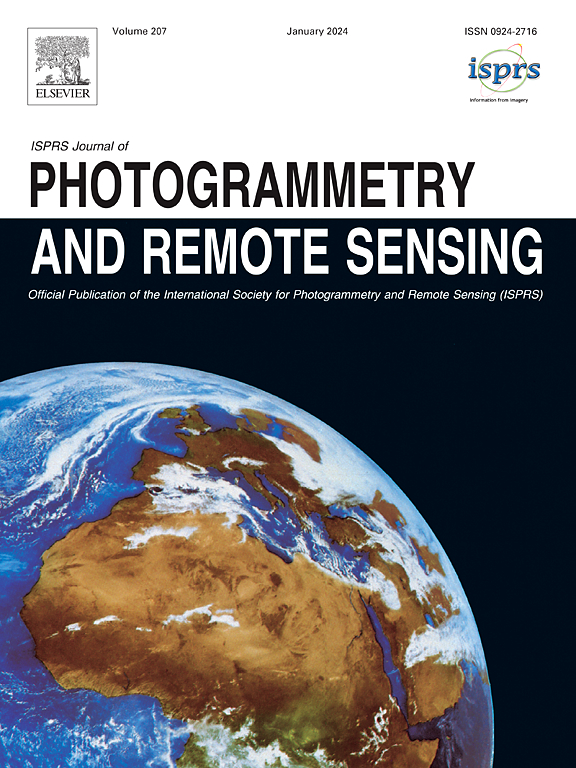近岸水域一种产毒鞭毛藻的光学性质及其Sentinel-2 MSI检测
IF 10.6
1区 地球科学
Q1 GEOGRAPHY, PHYSICAL
ISPRS Journal of Photogrammetry and Remote Sensing
Pub Date : 2025-06-26
DOI:10.1016/j.isprsjprs.2025.06.017
引用次数: 0
摘要
由甲藻亚历山大藻引起的有害藻华(HABs)对人类和生态系统健康构成威胁。不同种类的有害藻华可以在沿海水域共存,并在海岸线附近积聚,这给地球观测(EO)的探测带来了挑战。本文利用西班牙Rías Baixas (NW)的原位地理生物光学和分类数据,建立了一种新的鉴定a . minutum高浓度华花的方法,并将其应用于Sentinel-2多光谱仪(S2 MSI)。我们开发了一种名为A. minutum index (AMI)的方法,用于捕获A. minutum细胞在560 ~ 570 nm之间的低吸收和高后向散射特性。我们测试并验证了三种大气校正算法(C2RCC, POLYMER和ACOLITE)的性能,使用了原位和卫星衍生的Rrs之间的匹配。结果表明,C2RCC在大多数波长上的误差最小。将AMI应用于S2 MSI,结果表明,该方法能准确识别出高浓度微藻华(F1值为70%,Kappa值为68.3%,平衡精度为87.7%,MCC值为68.3%),并能将微藻华与其他浮游植物区分开。我们将AMI与现有的三种检测沿海水域有害藻华的指数进行了比较,发现我们的方法取得了更好的效果,NDTI、RGCI和NDCI的F1值分别为21.28、21.74和0.0%,MCC值分别为15.0、15.0和0.0%。我们还研究了S2 MSI对Sentinel-3海洋和陆地颜色仪器(S3 OLCI)的空间分辨率,以绘制细尺度的黄花变化。我们发现,S2 MSI的高空间分辨率数据对于检测近岸水域的小尺度变化非常有用,可以在水产养殖活动更为突出的Rías中部进行检测。这项研究还显示了准确的AC在近岸水域的重要性,在那里高浓度的水华可能更普遍。我们的研究结果表明,在近岸像素中观察到更大的AC误差,在那里,赤潮的社会经济和环境影响通常更严重。本文章由计算机程序翻译,如有差异,请以英文原文为准。
Optical properties of a toxin-producing dinoflagellate and its detection from Sentinel-2 MSI in nearshore waters
Harmful algal blooms (HABs) caused by the dinoflagellate Alexandrium minutum can pose risks to human and ecosystem health. HABs of different species can coexist in coastal waters and accumulate near the shoreline, challenging their detection through Earth observation (EO). In this study, we use in situ geo-bio-optical and taxonomical data from the Rías Baixas (NW Spain) to develop a new method for identifying high-concentration blooms of A. minutum and its application to Sentinel-2 Multispectral Instrument (S2 MSI). Our approach named A. minutum index (AMI) was developed to capture the low absorption and high backscattering properties of A. minutum cells between 560 and 570 nm. We tested and validated the performance of three atmospheric correction algorithms (AC) (C2RCC, POLYMER and ACOLITE) using matchups between in situ and satellite-derived Rrs. Results show that C2RCC had the lowest error across most wavelengths. Applying AMI to S2 MSI indicates that our approach can accurately identify high-concentration blooms of A. minutum (F1 score: 70 %, Kappa: 68.3 %, balanced accuracy: 87.7 %, MCC: 68.3 %) and discriminate blooms of A. minutum from other phytoplankton species. We compared AMI with three existing indices for detecting HABs in coastal waters and found that our approach achieved a better performance, with the NDTI, RGCI and NDCI yielding F1 scores of 21.28, 21.74, and 0.0 % and MCC values of 15.0, 15.0 and 0.0 %, respectively. We also investigated the spatial resolution of S2 MSI to Sentinel-3 Ocean and Land Colour Instrument (S3 OLCI) for mapping fine-scale variations in A. minutum blooms. We found that the higher spatial resolution data from S2 MSI were highly useful for detecting small-scale variations in A. minutum in nearshore waters, enabling their detection in the mid-inner part of the Rías, where aquaculture activities are more prominent. This study also showcases the significance of accurate AC in near-shore waters, where high-concentration blooms can be more prevalent. Our findings show that greater errors in AC are observed in near-shore pixels, where the socio-economic and environmental impact of HABs are typically more severe.
求助全文
通过发布文献求助,成功后即可免费获取论文全文。
去求助
来源期刊

ISPRS Journal of Photogrammetry and Remote Sensing
工程技术-成像科学与照相技术
CiteScore
21.00
自引率
6.30%
发文量
273
审稿时长
40 days
期刊介绍:
The ISPRS Journal of Photogrammetry and Remote Sensing (P&RS) serves as the official journal of the International Society for Photogrammetry and Remote Sensing (ISPRS). It acts as a platform for scientists and professionals worldwide who are involved in various disciplines that utilize photogrammetry, remote sensing, spatial information systems, computer vision, and related fields. The journal aims to facilitate communication and dissemination of advancements in these disciplines, while also acting as a comprehensive source of reference and archive.
P&RS endeavors to publish high-quality, peer-reviewed research papers that are preferably original and have not been published before. These papers can cover scientific/research, technological development, or application/practical aspects. Additionally, the journal welcomes papers that are based on presentations from ISPRS meetings, as long as they are considered significant contributions to the aforementioned fields.
In particular, P&RS encourages the submission of papers that are of broad scientific interest, showcase innovative applications (especially in emerging fields), have an interdisciplinary focus, discuss topics that have received limited attention in P&RS or related journals, or explore new directions in scientific or professional realms. It is preferred that theoretical papers include practical applications, while papers focusing on systems and applications should include a theoretical background.
 求助内容:
求助内容: 应助结果提醒方式:
应助结果提醒方式:


